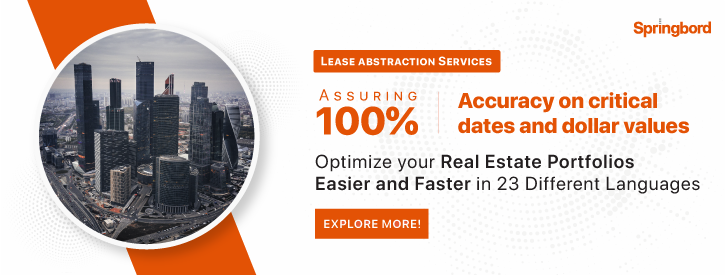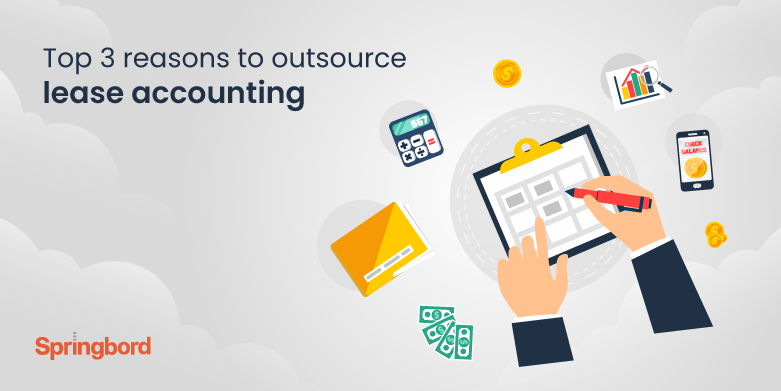 Read time 3 min
Read time 3 minAs a real estate company, Springbord understands the importance of knowing how to calculate lease liability. Whether you are a tenant or landlord, it is crucial to have an understanding of lease accounting principles to accurately calculate your lease liabilities.
In this blog, we will discuss the basics of operating leases and the accounting standards for ASC 840 and ASC 842, as well as provide practical examples to help you calculate lease liability effectively.
The definition of an operating lease.
An operating lease is a type of lease in which the lessee (the tenant) rents property from the lessor (the landlord) for a period of time that is typically shorter than the useful life of the asset.
In an operating lease, the lessor retains ownership of the property and is responsible for maintaining it, while the lessee only pays rent for the use of the property during the lease term.
Reporting an Operating Lease Under ASC 840
Under ASC 840, operating leases were treated as off-balance sheet transactions, meaning that the leased asset and corresponding liability were not recorded on the lessee’s balance sheet. Instead, the lessee was only required to record the lease payments as an expense on their income statement over the lease term.
To calculate lease liability under ASC 840, the lessee needs to determine the total lease payments over the lease term and discount them to present value using the lessee’s incremental borrowing rate. The Lessee’s effective rate of interest on a loan with the same term and payment amount as the lease payments is the incremental borrowing rate.
Invoking ASC 842 for Operating Lease Expenses
Under ASC 842, operating leases are now required to be recorded on the lessee’s balance sheet as both a right-of-use asset and lease liability. The right-of-use asset represents the lessee’s right to use the leased asset during the lease term, while the lease liability represents the lessee’s obligation to make lease payments to the lessor over the lease term.
Lessors must determine the total amount of lease payments due over the life of the lease and discount those payments to the present using either the lessee’s incremental borrowing rate or the rate implicit in the lease, if the latter is readily determinable, in order to comply with ASC 842. The rate implicit in the lease is the rate of interest that the lessor charges the lessee or is readily determinable by the lessee.
The ASC 842 method of recording changes to an operating lease
If there are modifications to the lease agreement, the lessee will need to adjust their lease liability and right-of-use asset. ASC 842 provides guidance on how to account for lease modifications, depending on the nature of the modification.
If the modification does not result in a new lease contract, the lessee should adjust the lease liability and right-of-use asset based on the revised lease payments and remaining lease term. If the modification does result in a new lease contract, the lessee should remeasure the lease liability and right-of-use asset based on the updated terms of the new lease contract.
Practical Examples
Let’s take a look at some practical examples to help you calculate lease liability under ASC 840 and ASC 842.
- Retail Store Lease: Suppose you own a retail store and have leased a space for 10 years. The monthly rent is $5,000, and the landlord has agreed to provide you with a two-month rent-free period. To calculate your lease liability, you need to multiply the monthly rent by the number of months in the lease term (10 years x 12 months = 120 months) and then subtract the rent-free period (2 months x $5,000 = $10,000). So, your total lease liability would be $590,000 ($5,000 x 120 – $10,000).
- Office Space Lease: Let’s say you are a startup and have leased office space for 5 years. The annual rent is $120,000, and the lease includes an option to renew for another 5 years at a rent increase of 5%. To calculate your lease liability, you need to multiply the annual rent by the number of years in the lease term (5 years) and then add the rent for the renewal period (5 years x $126,000 = $630,000). So, your total lease liability would be $750,000 ($120,000 x 5 + $630,000).
- Apartment Lease: Suppose you have leased an apartment for 2 years. The monthly rent is $2,000, and the landlord has required you to pay a security deposit of $4,000. To calculate your lease liability, you need to multiply the monthly rent by the number of months in the lease term (2 years x 12 months = 24 months) and then add the security deposit ($4,000). So, your total lease liability would be $52,000 ($2,000 x 24 + $4,000).
In all these examples, the lease liability is simply the total amount of rent that you are obligated to pay over the course of the lease term, plus any other costs or fees that you are required to pay upfront.
Conclusion
As a real estate company, Springbord understands the importance of accurate lease accounting to help calculate lease liability.
By understanding the basics of operating leases and accounting standards, you can ensure that your lease liabilities are accurately calculated.
For any further questions or guidance on lease accounting, please contact Springbord for expert advice.







